小学英语说课稿模板参赛专用PPT模板
- 格式:pptx
- 大小:965.65 KB
- 文档页数:12

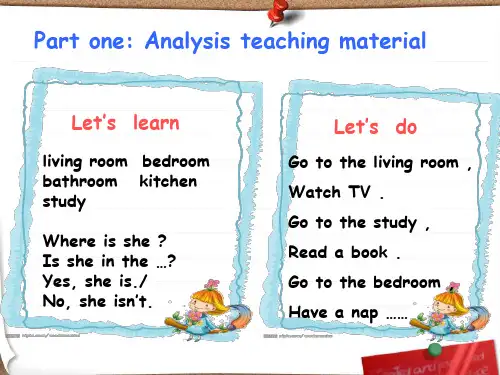
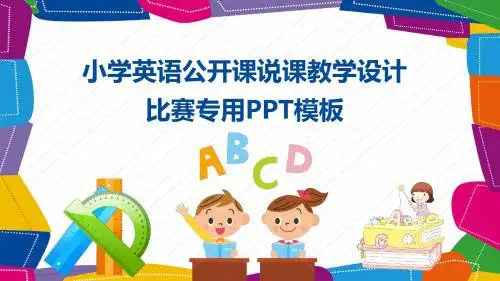
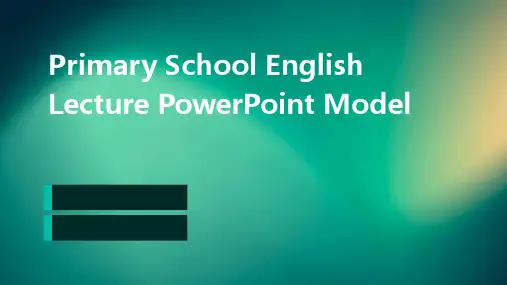
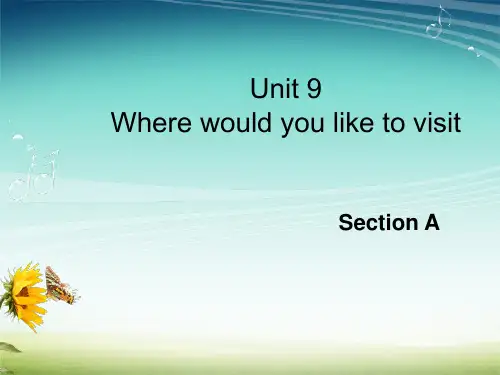
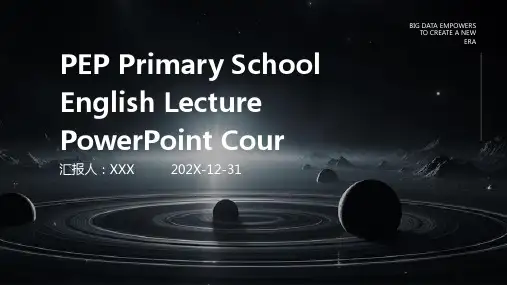
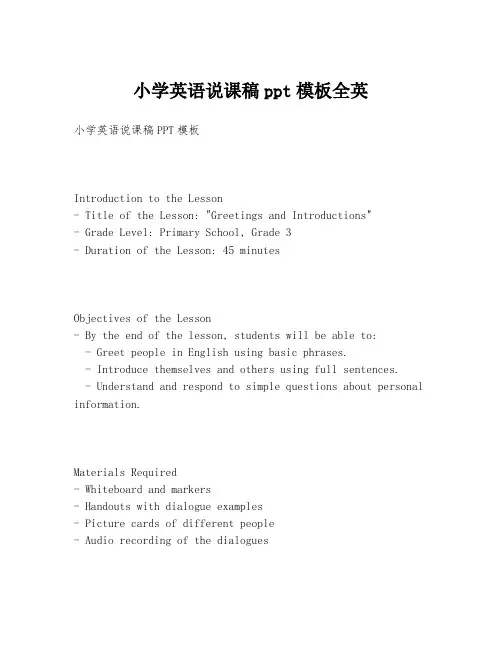
小学英语说课稿ppt模板全英小学英语说课稿PPT模板Introduction to the Lesson- Title of the Lesson: "Greetings and Introductions"- Grade Level: Primary School, Grade 3- Duration of the Lesson: 45 minutesObjectives of the Lesson- By the end of the lesson, students will be able to:- Greet people in English using basic phrases.- Introduce themselves and others using full sentences.- Understand and respond to simple questions about personal information.Materials Required- Whiteboard and markers- Handouts with dialogue examples- Picture cards of different people- Audio recording of the dialoguesTeaching Aids- PowerPoint slides with visual aids- Interactive games for practice- Role-play scenariosLesson Plan1. Warm-up Activity (5 minutes)- Greet the class and ask how they are feeling today.- Engage students in a quick game of "Simon Says" to get them moving and focused.2. Introduction of New Vocabulary (10 minutes)- Introduce key vocabulary words such as "hello," "good morning," "my name is," and "what's your name?"- Use picture cards to demonstrate the use of each phrase.3. Presentation of Dialogues (10 minutes)- Show PowerPoint slides with dialogue examples.- Play an audio recording of native speakers using the phrases.4. Practice with Chants (5 minutes)- Teach students a simple chant to help them remember the phrases.- Have the class repeat the chant together.5. Interactive Games (10 minutes)- Divide the class into groups and have them play a "WhoAm I?" game where they guess each other's names.- Use role-play scenarios where students introduce themselves to a new friend.6. Consolidation through Role-Play (5 minutes)- Assign each student a role and have them practice introducing themselves to the class.Assessment- Observe students during role-play and group activities to assess their understanding and use of the phrases.- Provide a short quiz at the end of the lesson to reinforce learning.Closure- Summarize the key points of the lesson.- Encourage students to practice greetings and introductions with their family and friends.Reflection- Reflect on the lesson's effectiveness and areas for improvement.- Consider student feedback and make adjustments for future lessons.Additional Resources- Links to online games and activities for further practice. - Suggested reading materials for students who want to expand their vocabulary.This template provides a comprehensive structure for a lesson plan focused on greetings and introductions in English for primary school students. Adjustments can be made based on the specific needs and abilities of the students.。

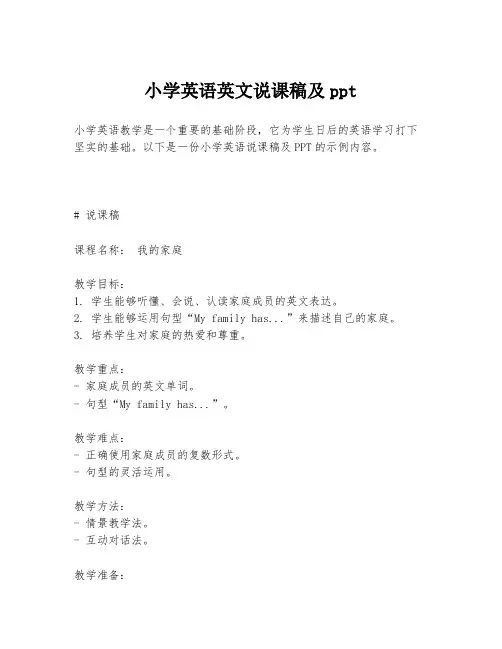
小学英语英文说课稿及ppt小学英语教学是一个重要的基础阶段,它为学生日后的英语学习打下坚实的基础。
以下是一份小学英语说课稿及PPT的示例内容。
# 说课稿课程名称:我的家庭教学目标:1. 学生能够听懂、会说、认读家庭成员的英文表达。
2. 学生能够运用句型“My family has...”来描述自己的家庭。
3. 培养学生对家庭的热爱和尊重。
教学重点:- 家庭成员的英文单词。
- 句型“My family has...”。
教学难点:- 正确使用家庭成员的复数形式。
- 句型的灵活运用。
教学方法:- 情景教学法。
- 互动对话法。
教学准备:- PPT课件。
- 家庭成员的图片。
- 录音设备。
教学过程:1. 导入新课:通过播放一首关于家庭的英文歌曲,激发学生对家庭话题的兴趣。
2. 新课呈现:- 展示家庭成员的图片,教授相应的英文单词。
- 通过PPT展示句型“My family has...”,并让学生跟读。
3. 操练:- 分组让学生用所学句型描述自己的家庭。
- 角色扮演:学生扮演家庭成员,进行对话练习。
4. 巩固练习:- 完成PPT中的填空题,加深对家庭成员单词的记忆。
- 进行小组竞赛,看哪个小组能更快更准确地使用句型“My family has...”。
5. 课堂小结:总结家庭成员的英文表达和句型的使用,强调家庭的重要性。
6. 布置作业:让学生回家与家人一起制作一个家庭树,并用英文标注家庭成员。
教学反思:- 反思学生在课堂上的参与度和学习效果。
- 思考如何改进教学方法,使课堂更加生动有趣。
# PPT内容概要1. 封面页:课程名称、教师姓名、学校名称。
2. 导入页:家庭主题的英文歌曲视频。
3. 新课呈现页:- 家庭成员图片及英文单词。
- 句型“My family has...”的示例。
4. 操练页:- 分组讨论的指导。
- 角色扮演的脚本。
5. 巩固练习页:- 填空题示例。
- 小组竞赛的规则说明。
6. 课堂小结页:家庭成员单词和句型的总结。
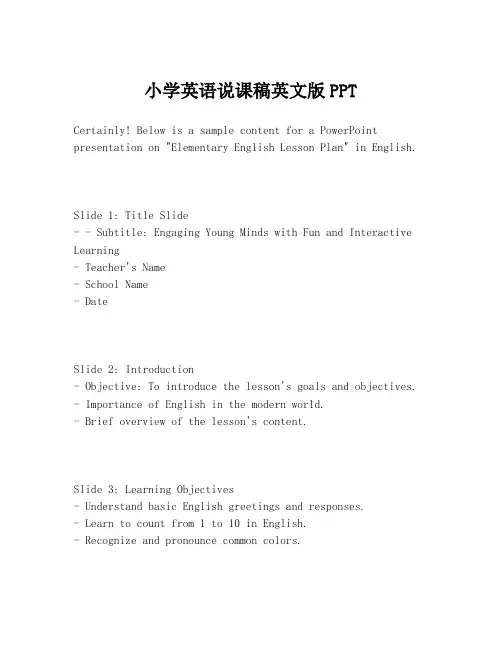
小学英语说课稿英文版PPTCertainly! Below is a sample content for a PowerPoint presentation on "Elementary English Lesson Plan" in English.Slide 1: Title Slide- - Subtitle: Engaging Young Minds with Fun and Interactive Learning- Teacher's Name- School Name- DateSlide 2: Introduction- Objective: To introduce the lesson's goals and objectives. - Importance of English in the modern world.- Brief overview of the lesson's content.Slide 3: Learning Objectives- Understand basic English greetings and responses.- Learn to count from 1 to 10 in English.- Recognize and pronounce common colors.Slide 4: Vocabulary- List of vocabulary words to be taught.- Visual aids for each word (e.g., pictures of fruits, animals).Slide 5: Warm-up Activity- Icebreaker game to get students comfortable with speaking English.- Example: "Two Truths and a Lie" about themselves.Slide 6: Greetings and Responses- Common greetings and responses in English.- Role-play scenarios for students to practice.Slide 7: Numbers 1-10- Visual representation of numbers.- Chant or song to help memorize the numbers.Slide 8: Colors- Introduction to primary and secondary colors.- Color identification game with flashcards.Slide 9: Reading Comprehension- Short story or poem for reading practice.- Questions to check understanding.Slide 10: Grammar Focus- Simple present tense for regular verbs.- Examples and practice sentences.Slide 11: Listening Activity- Audio clip of a short story or dialogue.- Listening comprehension questions.Slide 12: Speaking Practice- Group discussions or debates on a given topic.- Encouraging students to use the new vocabulary.Slide 13: Writing Activity- Guided writing exercise to practice forming sentences. - Peer review for constructive feedback.Slide 14: Assessment- Methods to assess student understanding.- Quizzes, oral tests, or creative projects.Slide 15: Differentiation- Strategies for different learning paces and styles.- Group work, individual tasks, or technology integration.Slide 16: Closure- Summary of the lesson's key points.- Reflection on what was learned and how it can be applied.Slide 17: Homework Assignment- Homework tasks to reinforce the lesson's content.- Reading, writing, or interactive online activities.Slide 18: Conclusion and Next Steps- What to expect in the next lesson.- Encouragement for students to continue practicing English.Slide 19: Contact Information- Teacher's contact details for questions or concerns.Slide 20: Thank You Slide- Express gratitude for the students' attention and participation.This PPT layout provides a comprehensive structure for an elementary English lesson, covering various aspects from introduction to conclusion, ensuring a well-rounded and engaging learning experience for young students.。
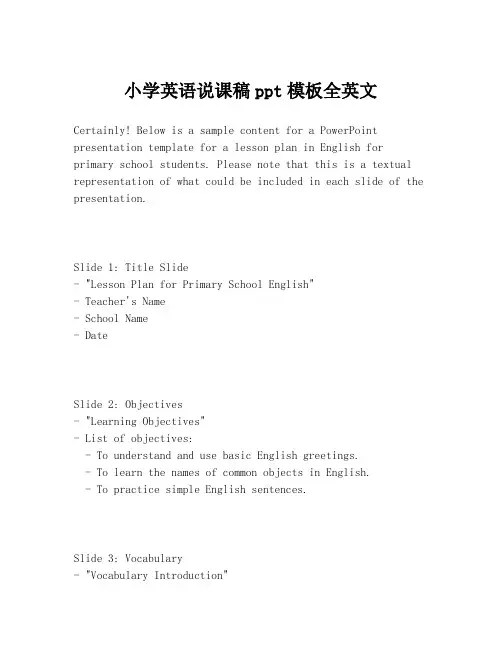
小学英语说课稿ppt模板全英文Certainly! Below is a sample content for a PowerPoint presentation template for a lesson plan in English for primary school students. Please note that this is a textual representation of what could be included in each slide of the presentation.Slide 1: Title Slide- "Lesson Plan for Primary School English"- Teacher's Name- School Name- DateSlide 2: Objectives- "Learning Objectives"- List of objectives:- To understand and use basic English greetings.- To learn the names of common objects in English.- To practice simple English sentences.Slide 3: Vocabulary- "Vocabulary Introduction"- List of new words with pictures:- Apple, Book, Cat, Dog, Elephant- Pronunciation guide for each word.Slide 4: Warm-Up Activity- "Warm-Up: Icebreaker"- Description of the activity:- Students will introduce themselves using their English names.Slide 5: Introduction of the Lesson- "Introduction"- Brief overview of the lesson content.- Importance of learning English.Slide 6: Presentation of Vocabulary- "Vocabulary Presentation"- Show pictures and repeat words.- Use flashcards for interactive learning.Slide 7: Practice Activity 1- "Practice Activity: Matching Game"- Students match pictures with the correct English words.Slide 8: Practice Activity 2- "Practice Activity: Word Association"- Students form pairs and take turns saying words and associating them with the correct picture.Slide 9: Grammar Focus- "Grammar Focus: Simple Sentences"- Introduce simple sentence structure:- Subject + Verb + ObjectSlide 10: Sentence Construction- "Sentence Construction"- Guide students in forming sentences using the new vocabulary.Slide 11: Group Work- "Group Work: Role Play"- Students work in groups to create a short dialogue using the new vocabulary and sentence structures.Slide 12: Assessment- "Assessment: Quizzes and Tests"- Description of how students will be assessed:- Vocabulary quizzes.- Sentence construction tests.Slide 13: Wrap-Up- "Wrap-Up and Reflection"- Summary of the lesson.- Reflection on what was learned.Slide 14: Homework- "Homework Assignment"- Tasks for students to practice at home:- Write sentences using new vocabulary.- Prepare a short presentation on their favorite animal in English.Slide 15: Additional Resources- "Additional Resources"- Links to online games, videos, and reading materials for further practice.Slide 16: Closing Slide- "Thank You for Your Attention"- Contact information for questions or further discussion.This template is designed to be flexible and can be adapted to various topics and lessons in primary school English. The content should be visually engaging with the inclusion of images, diagrams, and interactive elements to cater to the learning styles of young students.。
小学英语说课稿各位评委老师好我说课的课题是冀教版小学英语三年级下,unit3 lesson 19 vegetables and fruit.我将从教材分析、教学方法、教学过程等方面展开说课。
一.教材分析1.本节课在教材中的地位和作用这节课是围绕食物题材而展开的教学活动,学生通过这节课的学习能够更好地用英语表达自己的思想和感受,这节课是整个模块的重点,占有很重要的地位,为后一单元的学习奠定了基础。
2.教学目标根据《英语课程标准》要求,我在认真分析教材的基础上,针对学生的实际情况,将教学目标确定为以下几点:知识方面:说、认识、口头运用下列词汇:vegetables, fruit, morning, afternoon, evening.能够表达自己对各种食物的喜好、需求:I like…I don’t like…能力方面:(1)能把所学单词运用到日常口语交际中,在适当的情境中能够灵活运用,如谈论自己对各种食物的喜好、需求。
(2)帮助学生了解中西方文化的差异,拓展视野。
情感、态度、价值观方面:关注学生的喜好、需求,营造宽松、民主、和谐的课堂氛围。
通过多样性的活动,激发学生学习英语的兴趣,调动积极性,使学生在英语课堂中不断体验成功,感受乐趣,树立自信心,促进学生综合语言运用能力的发展。
3.教学重点:说、认识、口头运用vegetables, fruit,表达自己对各种食物的喜好、需求是本课的重点。
4.教学难点:让学生理解新学句型I do in the morning /in theafternoon/ in the evening ,并能在相应的语境中灵活运用。
二.教学方法为了顺利完成教学目标,更好地突出重点,突破难点,我根据小学生好奇、好动的特点,采取了情景假设法、直观演示法、游戏法相结合的教学方法,鼓励学生多开口、多交流,激发学生学习英语的兴趣,提高他们学习英语的积极性。
三.学习方法我在课堂教学中,运用多种方法促使学生多听、多读、多说,通过实践提高学生英语的灵活运用能力,学生在互动、交流的活动中建立起自信,享受到学习的乐趣,进而促使他们形成自主、探究性的学习方法。